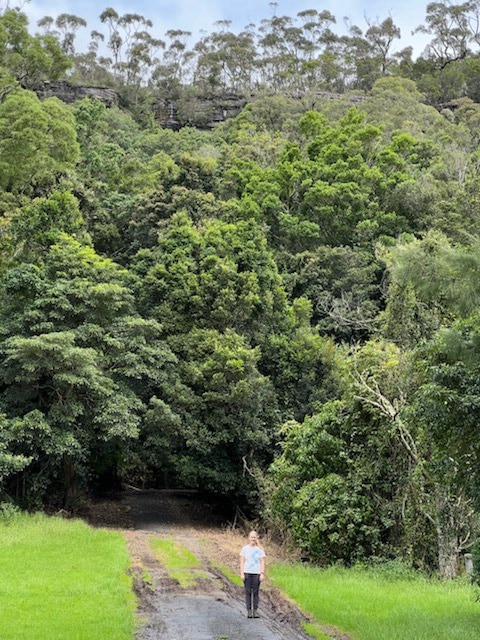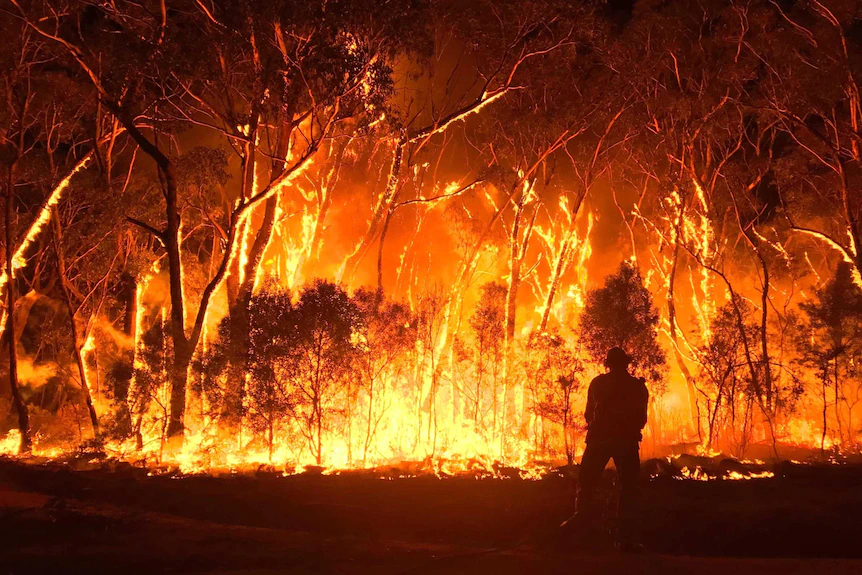In Bellawongarah, sundown is replaced by a moment of silence. Then the “symphony of the evening” begins.
The gentle rustling of trees gives way to a cacophony of croaks and hoots as nature comes alive.
Nestled between Berry and the Kangaroo Valley in the NSW Shoalhaven region, about 130 people call the quaint mountain community home.
Surrounded by temperate rainforest and rolling valleys, it’s easy to understand Bellawongarah’s hold.

However, in recent years, something has changed.
First, the frogs and snakes disappeared, and with it the amphibians’ nightly melody — the side-effect of a drought that relegated dams to a “murky puddle” and dried out the once-damp rainforest.
Then the bushfires came.
While Eleanor’s parents’ property was spared, as she watched wildlife seek shelter in her back yard from the inferno around them, the magnitude of the situation became clear.
“It was quite scary because, for months on end, we just could smell smoke in the air just travelling up the coast,” she says.
“But it did also make me want to act and to speak out after seeing the effects of climate change in my own life and my own community.”
For young Aussies, it’s personal
Young Australians are front and centre of the climate crisis and, in the face of extreme weather events across the country, it’s a story shaped by personal experience.
Our World, Our Say — the nation’s largest consultation of children and young people on climate change and disaster risk, led by the Australian Institute for Disaster Resilience and World Vision — surveyed 1,447 young Australians between the ages of 10 and 24 years.
The 2020 report found that than 80 per cent of participants aged over 16 years were concerned or extremely concerned about climate change.

Greater than 90 per cent of those surveyed reported experiencing at least one natural hazard event in the three years prior, while 63 per cent felt that disasters were occurring more often.
“We had to evacuate with the bushfires, which obviously was a major experience that I’ll always remember,” Eleanor says.
“And so people just think, ‘Oh, it’s just climate change, it’s just the world warming’. But it’s got such major consequences.”
Loading
As swathes of Australia’s east coast grapple with the fallout from sustained rainfall and flash flooding, the conversation has again turned to the nation’s climate response.
However, this time, it’s young people who are making their voice heard.
As tens of thousands of students descended on School Strike For Climate rallies across the country last month, teenagers affected by the floods spoke of becoming “climate refugees”.
“Have you ever had to flee from your house, in the middle of the night, in the middle of a storm, scared out of your mind because you don’t know what’s going to happen, or if you will survive, or if your house will still be OK, or if your friends are OK?” Ella O’Dwyer-Oshlack, 13 — who lost her house during Lismore’s flood catastrophe — told crowds outside Kirribilli House.
“It’s not something I would wish on anyone.”
Direct exposure to extreme weather events can take a toll
Emerging Australian and international evidence suggests that children and young people who are directly exposed to extreme weather events are at risk of a range of psychological effects.
One study investigating the impact of 2020’s Black Summer bushfires on young people — led by researchers at the University of New England — found that those directly exposed to the crisis reported significantly higher levels of depression, anxiety, stress, adjustment disorder symptoms, as well as drug and alcohol use than those who were not.
The study — which involved a survey of 740 young people in New South Wales between the ages of 16 and 25 years — also found that those who were directly exposed were more likely to believe that climate change was going to affect them, or people they knew.
Associate Professor Amy Lykins says there needs to be a greater focus on bolstering support services in regional and rural communities to build psychological resilience to challenges that climate change will bring.
“Building that up and building up that community capacity is really important to help provide better opportunities for resilience going into the future,” she says.
With the Black Summer fires preceded by severe droughts in some areas, and followed by floods in others, experts also point to the cascading and compounding impacts of successive major weather events, which can affect people’s ability to recover.

Doom and gloom isn’t always the answer
As young people find themselves on the front line of climate change, the classroom has become somewhat of a battleground.
In Western Australia, an inquiry into the response of schools to climate change is currently underway, while Victoria’s draft climate change adaptation plan is exploring what can be done to ensure schools and early childhood education services are able to “withstand more extreme weather”.

While the complexity of climate change may leave some feeling there is little that can be done at an individual level, in a classroom in Canberra, one teenager is trying to change the climate around climate change, one student at a time.
For the high school student, it’s a topic as exciting as it is challenging.
When he first joined his school’s environment group, he was faced with a quandary: How do you get a bunch of teenagers to think recycling is interesting?
“I thought, ‘Why don’t we do something that’s really different?’ If it’s funny, it’s memorable and people are more likely to remember the messages,” Joji says.
During their monthly assembly, the group stages wheelie bin races and “Binja Warrior” style obstacle courses, where contestants must dodge obstacles to put rubbish in the bin.
It’s an unconventional strategy designed to “bridge the gap between our actions and impacts”, and create a connection between the smell of sorting bins and the camaraderie of competition.

“Our work in the environment group has showed that people do care, that they are able to change their habits for the good of the environment,” Joji says.
“We can be doing small things to tackle some of these climate issues.”
‘We can just slow it down’
Reflecting on the future, Joji is candid: “I think there’s still time to change.”
“There’s definitely still time and that, if we change our habits now, we’ll be able to stop climate change from becoming a big problem in the future,” he says.
For Eleanor, who has seen the changes on her property first-hand, it’s a sentiment that prompts mixed emotions.
The onus has been put on younger generations to come up with a solution to climate change, she says.
After fires tore through the landscape around Bellawongarah, the rains followed — and, with it, the once-lost frogs and snakes returned.
These days, life almost resembles what it once did.

However, the wood ducks don’t breed there anymore, Eleanor says, while animals once deterred by the temperature and altitude now feel at home further up the mountain.
“It isn’t just big things like icebergs melting,” she says.
“Climate change can affect everyone and even in just the smallest of ways.”
The ABC’s Heywire competition is open to all regional Australians aged between 16 and 22.
The annual competition provides a platform for the younger generation, in pockets of Australia that rarely see the spotlight, to “tell it like it is”.
If you are aged between 16 and 22 and would like to find out more about the ABC Heywire Competition, go to the ABC Heywire website.

